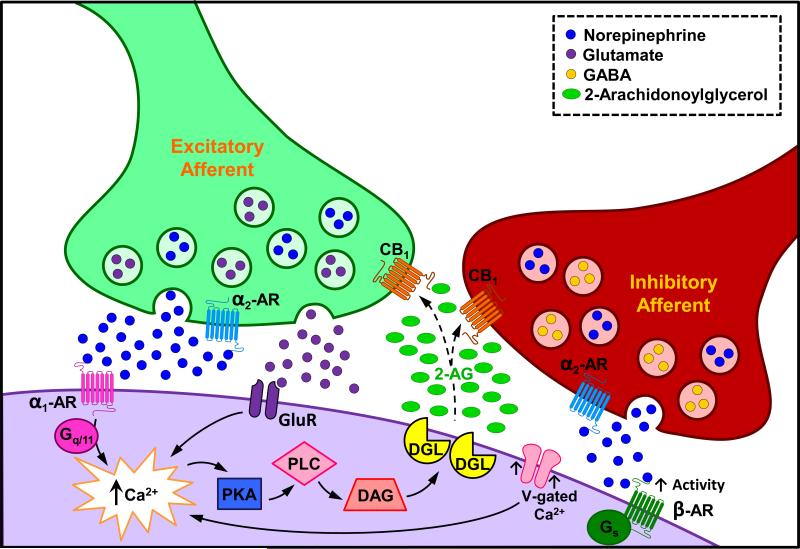Figure 6.
Schematic diagram depicting proposed mechanisms underlying modulation of NE afferents by the eCB system. Noradrenergic axon terminals that express CB1r may co-localize inhibitory transmitters, such as gamma-amino butyric acid (Hajos et al., 2000; Ranganathan and D'Souza, 2006), or may co-localize excitatory transmitters such as glutamate (Katona et al., 2006; Kawamura et al., 2006). Excitatory ionotropic or G protein-coupled receptor activation (via excitatory amino acid, alpha1 or beta-adrenergic receptors), stimulate calcium production and engage intracellular pathways that contribute to local eCB synthesis and release. Following activation, 2-AG may diffuse into the synapse and bind to CB1r located on noradrenergic terminals that co-express inhibitory or excitatory transmitters. Functional consequences of eCB modulation of cortical afferents include inhibition of inhibitory neurotransmitter release as cannabinoids have been shown to reduce inhibitory neurotransmitter efflux (Trettel and Levine, 2002; Zamberletti et al., 2014) and increased excitatory neurotransmitter release (Galanopoulos et al., 2011). Once NE is released, the possibility exists that it could bind to pre-synaptically distributed alpha2 adrenergic receptors that are coupled to inhibitory Gi proteins, and through their activation, further tonically inhibit NE. In addition to alterations in NE, retrograde suppression of inhibitory neurotransmitter release and increases in excitatory neurotransmitter release in FC may affect synaptic integration and cortical neuronal activity. Furthermore, it is also feasible that NE activates the beta adrenergic receptor thereby increasing neuronal activity by activation of voltage-gated calcium channels (Yu et al., 2015) thereby increasing calcium influx resulting in neuronal depolarization and consequently increased 2-AG production.

